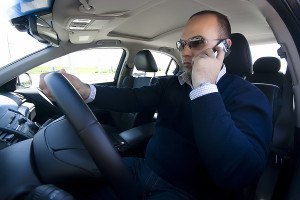Though a large majority of drivers support laws prohibiting cellphone use while driving one thing is apparent: people are still using them.
State Farm surveyed consumers about when they were more or less likely to use their phones when driving. Among drivers who indicated they use their cellphone while driving, the percentage of drivers who say they are more likely to use their cellphone when:
- Stopped at a red light – 63 percent
- On an open highway – 30 percent
Percentage of drivers who say they’re less likely to use their cellphone under these conditions:
- Dark outside – 75 percent
- Fog – 91 percent
- Snow – 92 percent
- Icy – 93 percent
- Heavy traffic – 78 percent
- Construction zone – 87 percent
- Rain – 88 percent
- School zone – 83 percent
One particularly troubling finding: at least ten percent of respondents reported that driving in school zones and construction zones has no impact on their cellphone use.
“It’s interesting to see that many drivers report assessing driving conditions when they make choices regarding using their cellphones,” said Chris Mullen, director of Technology Research at State Farm. “However, we want to remind people that there are demands on their attention when driving whether moving or not, and to please stay 100 percent focused on their drive.”
Six year trends
For six years State Farm has been conducting this survey of people’s attitudes and behaviors when it comes to cellphone use while driving, and trends have emerged.
- There has been a steady reduction in the number of drivers talking on a hand-held cell phone.
- The number of people who report texting while driving has remained stable over six years.
- Smartphone ownership is growing. In 2011, 52 percent of drivers reported owning a smartphone, and by 2014 that number grew to 80 percent. We see the greatest increases in smartphone ownership among adults age 40 and older.
- Smartphones create new distractions. There is a significant increase over six years in drivers using their phones for: accessing the Internet, reading email, responding to email, programming and listening to a navigation system and reading social media.
- Drivers are more likely to talk on a hand-held phone than they are to text message while driving. Both of these activities are the greatest for drivers ages 18-29 and decreased as the age of drivers increased.
- There has been an increase in the percentage of drivers who say they talk on a hands-free cellphone while driving. This is possibly due to advances in hands-free technology and enactment of laws restricting hand-held use.
“These six-year trends make it apparent that smartphones have created many new distractions for drivers to juggle,” Mullen said. “While much attention is paid to the dangers of talking and texting while driving, it’s critical that we also address the increasing use of other smartphone features and other sources of distraction.”
Source: State Farm
Was this article valuable?
Here are more articles you may enjoy.


 In Fight Over Insurance, Neighbors Crowdsource LA Fire Contamination Data
In Fight Over Insurance, Neighbors Crowdsource LA Fire Contamination Data  Uber Spends Six Figures on Ads in Latest NY Insurance Reform Push
Uber Spends Six Figures on Ads in Latest NY Insurance Reform Push  Report: Insurers Pay $1.6B in Dog Bite Claims, as Frequency Soars
Report: Insurers Pay $1.6B in Dog Bite Claims, as Frequency Soars  Uber Sued by FTC Over ‘Deceptive’ Subscription Sign-Ups
Uber Sued by FTC Over ‘Deceptive’ Subscription Sign-Ups 